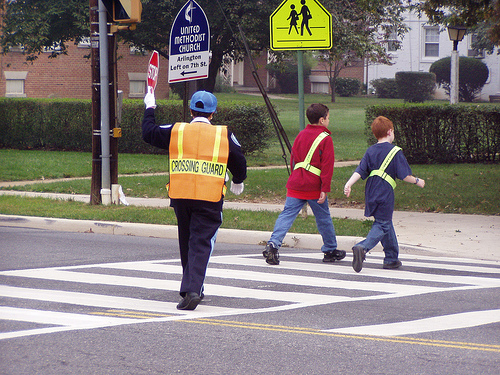Recent study finds reasons to walk to school, and why certain kids aren’t
Everyone has that one relative who can’t wait to regale them with stories of “When I was your age, I trudged to school in the middle of a snowstorm…” These days, kids are walking to school less and less. The results have greater implications than just a lack of stories to tell their future grandkids about the perils of walking in the snow: there is actually a noticeable impact on health as a result of fewer trips by foot to school.

Image from Arlington County.
Just a few weeks after International Walk to School Day, a recent study was released, studying 720 Toronto students attending fifth and sixth grade at 16 public schools and examining the relationship between neighborhood characteristics, parental perceptions of traffic safety,and the impact of the child’s gender.
What is so important about walking to school? In Canada, guidelines suggest one hour of “moderate to vigorous intensity physical activity” per day, every single day, for children and youth. Studies have also suggested that regular participation in either active transportation or physical activity can also positively impact children’s social well-being and cognitive ability. Kids who start engaging in physical activity at a younger age are also more likely to continue a healthy lifestyle over their lives.
So how does school transportation impact this? Getting to and from school is the most common trip for kids during school-year weekdays. According to the study researchers, many kids live within a “reasonable” walking or cycling distance from the school; for kids like these, AST (active school transport), “can be a great opportunity to accumulate physical activity on a regular basis.” In fact, research already supports this, suggesting a relationship between AST and more increased physical activity.
Yet despite the benefits, AST is on the decline over the last few decades and Western countries. And in greater Toronto, the rate of walking to school by 11 to 13-year-olds has dropped, from 53% to 42% between 1986 and 2006. As the researchers write, “This decline in AST levels may have major consequences for children’s health.”
For this particular study, researchers delved into two issues: the first, the relationship between “measurable environmental qualities” and parental perceptions of traffic safety, and, secondly, the variations of this relationship based on the child’s gender, as related to their school travel mode choice (walking versus being driven) in Toronto.
What the study discovered was that boys are more likely to walk to school compared to girls; it also found that neighborhood environment-related influences on walking varied across gender. Also, parents’ perceptions of traffic safety were found to have had a stronger association with travel outcomes among boys compared to girls.
Certain factors impact on whether or not the kids would walk to school, such as the availability of a private car, which meant it was more likely for kids to drive, not walk. Other associations, however, were disproved; for example, there was no relationship between whether a mother was employed and how a child would get to school.
As for parental perceptions of safety, the parents’ perception of walking infrastructure did play a “significant role” in influencing whether a child would walk to school. This perception was negatively related to school travel distance and missing sidewalks, for example. Major road crossings were shown to improve the likelihood of walking to school for both girls and boys, which, as the authors note, is contrary to other study findings, which have reported a negative relationship between road crossings and the likelihood of walking. The researchers suggest that major roads might be symbolic of a well-connected street network, “which in turn, may enable walking.”
Some of the study’s important takeaways may influence policies designed to increase children’s physical activity levels as well as AST. Understanding the gender differences related to school transportation, point out the researchers, such as the finding that “parental limits in control and mobility may be stronger for girls and boys,” may better inform policies, and help policymakers recognize these gender gaps.
Learn more about the benefits of walking for kids, from improved concentration and more time spent in the environment to reduction in diabetes and obesity and increased bone health.
Related Posts
Category: News, Transportation

















